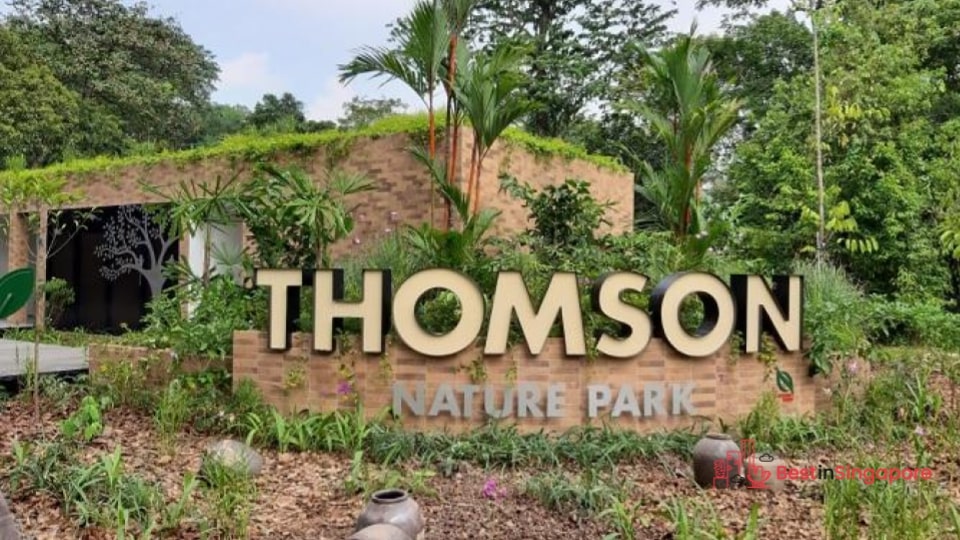A Guide to Discovering the Wonders of Thomson Nature Park
Thomson Nature Park is one of Singapore’s best natural parks because it offers a unique blend of heritage and nature. You can explore preserved ruins amidst freshwater habitats for an enriching experience in history and biodiversity.
Want to learn more? Put on your hiking boots and join us today to learn about Thomson Nature Park’s history, along with the wonderful flora and fauna it has to offer!
Brief Background & History of Thomson Nature Park
Stepping into Thomson Nature Park is like entering a lush time capsule. Here, a thriving secondary forest teems with biodiversity.
Thomson Nature Park is a living testament to its rich past, with roots reaching back to the 1930s when it thrived as Hainan Village. Back then, it was a vibrant community that welcomed families from diverse racial backgrounds.
— From _cfsm63
Amidst the vibrant vegetation and wildlife, the poignant ruins of Hainan Village stand as silent storytellers, narrating tales from days long gone by through informative signboards.
In the 1980s, the village was cleared, and the land reverted to the state. Nature reclaimed the area, leading to the regeneration of a secondary forest.
Thomson Nature Park opened in 2019, serving as a green buffer for CCNR (Central Catchment Nature Reserve) and preserving the site’s cultural heritage. The park covers an area of approximately 50 hectares (123.5 acres).
Best Time to Go
Park opening hours: Daily, 7 AM – 7 PM. Access to the park is strictly prohibited after 7 PM.
Early mornings are often the best time to go to Thomson Nature Park for birdwatching and observing wildlife. The temperatures are cooler, and many animals are more active during this time.
If you’re a photographer, consider visiting during the golden hour, which is usually around sunset, for beautiful lighting.
It’s a good idea to avoid the wettest months, which are typically November to January. The park may be muddier during these months and accidents are more likely to occur. If you’re unsure of the chances of rain, you can call 65427788 for a weather forecast.
Things to Know
Address: Upper Thomson Road, Singapore (Google Maps)
Entrance: There are 3 entrances to Thomson Nature Park: Main Entrance on Upper Thomson Road, Macaque Trail on Old Upper Thomson Road, and Langur Trail on Old Upper Thomson Road. Entrance 1 is the most accessible as it’s just a 2-minute walk from the Aft Tagore Dr bus stop. Entrances 2 and 3 are convenient for visitors coming from Lower Peirce Reservoir.
Contact: +6518004717300
Fees: There’s no entrance fee, but groups with 30 or more participants require a prior application for the nature reserve and park access.
Trails: Five designated trails cover a 3.8 km stretch along the former village road network.
Parking: Parking lots can be found near the main entrance. Inside the park, there are 30 parking spaces distributed across four clusters.
Accessibility: Wheelchair access is available exclusively at the entrance node.
Restrooms: There’s one public toilet near the main entrance (Google Maps).
Pets: Not allowed
How to Get There
Bus: Board Bus 138, 167, 169, 860, or 980 and get off at either the Aft Tagore Dr bus stop (56061) or the Bef Tagore Dr bus stop (56069). Walk to the main entrance of Thomson Nature Park.
MRT: From Upper Thomson Station (Exit 5), take bus 167 or 980 to the Aft Tagore Dr bus stop. Walk approximately 200 metres to reach the main entrance of Thomson Nature Park.
Car: Drive to Upper Thomson Road. Limited parking is available near the main entrance, so please be aware of space constraints
Carpark hours: Daily, 7 AM – 7 PM. If the park’s lot is full, there are two alternative car parks south of Thomson Nature Park: Casuarina Road Carpark and Roadside Carpark along Old Upper Thomson Road near Nemesu Avenue.
Taxi / taxi alternatives: Simply provide the park’s address or mention “Thomson Nature Park” to the taxi driver. Taxi and ride-sharing drivers in Singapore are usually knowledgeable about popular destinations like nature parks.
Bicycle / motorbike: Motorcycle and bicycle parking is available near the carpark but limited to less than five spaces each. Note that bikes and motorbikes aren’t allowed inside the park itself.
What to Expect, See, and Do in the Park
— From eternallove_3783
Go hiking on the designated trails
Discover the five curated trails covering 3.8 km along the former village’s road network. These paths offer insights into kampung life and the park’s diverse flora and fauna.
Need recommendations? Here are our two faves: the Ruins and Figs Trail showcases Hainan Village’s heritage, while the Stream and Ferns Trail highlights freshwater habitats and aquatic life.
Get to know the rambutan fruit’s legacy
— From fionaplantlove
During your walk, you’ll encounter some wonderful rambutan trees on-site, a reminder of the area’s rich history as a thriving rambutan hub. The Hans family, among the best rambutan sellers in Singapore, once resided here.
Trail signage delves into this history, as Thomson Nature Park was originally a Hainanese settlement known for its chicken rice and the cultivation and sale of rambutans to supplement income.
Get up close and personal with some wildlife
— From edwinteokimleong
Thomson Nature Park lives up to its promise of diverse fauna. During your visit, you’re likely to encounter macaques and langurs along the Stream and Ferns Trail, wild boars near the Ruins & Figs trail, birds and squirrels in the treetops, and get this—even snakes!
Of course, if you come across a snake, it’s best to exercise common sense. Admire it if you like but keep a safe distance, as some may pose a danger.
Visit the country’s old water source
— From elftraveltour
The trails also lead past abandoned wells, pottery jars, building foundations, and old road networks, all remnants of a Hainanese village. In particular, the wells provide a glimpse into its past and the pre-PUB era when water sourcing was essential for daily life.
Take panoramic pictures via the viewing decks
— From corrinne211
The park’s trails are heaven for both nature enthusiasts and Instagrammers. You’ll be lucky if you don’t end up taking a hundred photos.
Here’s a tip if you want even better shots: you can also make use of the convenient viewing decks for elevated photography and panoramic views of the surrounding areas.
Hiking Tips
— From mani.0128
Check the weather forecast first
— From lindasklee
Before your hike at Thomson Nature Park, be sure to check the weather forecast. If you’re already at the park, prioritise safety during and after bad weather. Seek shelter at the nearest available location and refrain from entering forested areas.
Wear comfy hiking clothes
— From panlinglingg
Opt for comfortable hiking attire and remember to wear sunscreen as Thomson Nature Park offers limited shade. Be cautious of slippery trails when it’s wet, so choose hiking footwear with strong grips, particularly in the rainy season.
Spray on insect repellent
— From marinashi_macro_clicks
Insects and other crawling critters are part and parcel of the park’s gorgeous flora and fauna, but you don’t want to come away with unwanted bites! So, spray on some trusty mosquito repellent if you don’t want to go home itching and scratching.
Bring your own water bottle
— From yin_2u
It’s advisable to bring your own water bottle on your visit to Thomson Nature Park, already filled with water from home. There’s a water fountain near the restroom, but err on the side of caution and just bring your own.
Carry little trail snacks
— From mandepainting
Currently, there are no on-site dining options. Bring snacks like protein bars or trail mix if you think you might get hungry during your visit, as the nearest eatery is approximately a kilometre away.
Pocket your snack packaging and dispose properly when you’re out of the park.
Rules/Things to Remember
— From albertgdh
No Pets Allowed
— From ruthhughes6889944
Pets, particularly dogs, can disrupt the natural behaviour of wildlife in the park. Their presence, noise, and scent can scare away or stress out native animals and birds.
Ensuring pets are clean and healthy can also be challenging. Pet waste, if not properly cleaned up, can introduce health hazards to the environment and other visitors.
No Fishing
— From maru1a
Thomson Nature Park has delicate and sensitive environments that could be harmed by fishing activities, including damage to aquatic plants and the lake bed.
Fishing activities can disturb the habitat and nesting areas of aquatic species, impacting their survival and breeding patterns.
No Motorbikes, Bicycles, or Mobility Devices
— From edwinteokimleong
Allowing bicycles, motorbikes, and mobility devices in natural areas can lead to soil erosion, trail damage, and harm to vegetation. This can have a negative impact on the park’s ecosystems and overall environmental health.
Plus, not all the trails are paved so it can limit movement on wheels.
No Entry in Non-Designated Trails
— From melanderings
For safety, stick to designated trails to prevent getting lost. The park hosts diverse native flora and fauna, and off-trail activity can disturb wildlife and harm endangered plants.
Entering undesignated areas is against park regulations, with a fine of up to S$2,000.
No Picking of Plants, Fruits, or Flowers
— From anarchetype
Allowing plants to complete their life cycles, including flowering and fruiting, is crucial for the preservation of genetic diversity within plant populations. Picking plants disrupts this natural process.
Many animals and insects also depend on these plants and fruits for food and shelter. Removing them can negatively impact the local wildlife by reducing their food sources and habitat.
No Feeding or Disturbing of Wildlife
— From drewrandalll
Feeding wildlife with human food can lead to malnutrition and health problems for the animals. Human food may lack essential nutrients that wildlife require, and it can cause digestive issues.
Moreover, feeding wildlife can alter their natural behaviours. They may become dependent on human food sources, which can lead to aggressive behaviour when food is not provided, disrupt their hunting or foraging patterns, and reduce their ability to find natural sources of food.
No Plastic Bags
— From mothershiponearth
Wildlife, particularly birds and aquatic animals can mistake plastic bags for food. Ingesting plastic can lead to injury or death for these animals.
Plastic bags are made from petroleum-based materials and can take hundreds of years to decompose in the environment. During this time, they can release harmful chemicals and contribute to pollution.
No Littering
— From nwpicker
Litter can pose a danger to wildlife. Animals may ingest or become entangled in the litter, leading to injury or death. Additionally, discarded food can attract pests and scavengers, which can disrupt the park’s ecosystems.
Enforcing a no-littering policy promotes environmental awareness and responsible behaviour among park visitors. It encourages individuals to take responsibility for their waste and its impact on the environment.
Observe Silence
— From nature.travel.yoga
Many animals are sensitive to noise and may become more active and visible when the environment is quiet. Observing silence increases the chances of encountering wildlife in their natural habitat.
Also, observing silence shows consideration for other visitors who may be seeking a peaceful and contemplative experience in the park. Loud conversations or music can disrupt their enjoyment.


